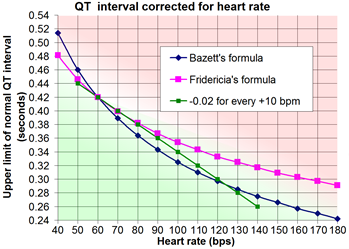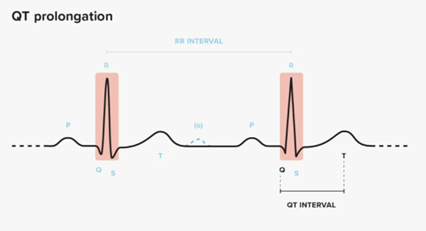There is evidence of QT prolongation in situations such as arrhythmia and other heart diseases. In addition to the mentioned situations, the process can also occur due to the effects that happen after the use of certain medications. If you need to calculate the QT interval as accurately and quickly as possible, you are in the right place. Today we are talking about a QTc calculator that you can use to correct the interval for the recorded heart rate of the subjects. In this article, we will explain the detailed meaning of this interval, the methods of calculation using several commonly used formulas, and the risks that lead to prolonging the duration of the interval.
What is the QTc/QT interval?
The QT interval is an electrocardiogram (ECG) showing the total process time from ventricular depolarization to complete repolarization. Simply put, this interval shows the time it takes for the heart’s chambers to contract and relax, that is, to depolarize and repolarize again. The beginning of the process is manifested at point Q, which represents the beginning of the wave, and lasts to point T, which is the end of the wave. If there is no Q wave, then the starting point of the process is the beginning of the R wave.
These points form the so-called QRS complex represent the beginning of depolarization. This complex is a combination of Q, R, and S waves, and its name can be confusing because some ECG leads do not contain all three waves. We distinguish different types of QT intervals. The most controversial one is normal when a standard heart rate is observed, below 400 to 440 milliseconds (0.44 seconds). This can vary, depending on the sex and age of the person, and anything above or equal to 0.50 seconds is considered dangerous to the health of the subjects. You can easily spot if an extended QT interval has occurred in such a way that the T wave ends above half of the RR interval. An interesting fact about the duration of the QT interval is that the female part of the population has a more extended period of the QT interval compared to the male part of the population. Also, a longer QT interval may indicate a lower heart rate.
Many factors affect or make it challenging to measure intervals. In addition to a person’s age, gender, and heart rate, if a person is taking medication or has problems with autonomic nerve tone, it can lead to complexity in interpreting the broadcast interval. Sometimes errors occur when reading waves because sometimes the end of a T wave is not clearly defined. Since the measurement of the QT interval is also affected by the heart rate, it is recommended to calculate the correction of QT interval. The fact is that many nurses and medical technicians neglect to measure this interval. In many cases, it can help identify potential problems that can be fatal to a patient’s life. Also, if irregular wave rhythms are read, the best thing you can do is to measure an average of five times the QT interval and do an average of the recorded results.
How to calculate QTc?
Here’s how you can use our calculator to help you calculate your QTc:
The first step you need to do is to find the beginning of the Q wave, which is also the beginning of the QRS complex, and accordingly determine the end of the process, more precisely the T wave. Once you have selected the starting and ending points, you need to measure the length of these points using a ruler. Then you need to measure the number of “boxes” from the beginning to the end of the beat and multiply by 0.04 seconds. For example, if you counted 9 “boxes”, then the duration of the QT interval would be 0.36 seconds. You need to enter the result you get in the field provided for that amount in our calculator. Since you also need to enter the heart rate per minute, you can measure this by monitoring the RR interval while following the same steps performed when measuring the QT interval. After the calculation, you need to enter the data into the calculator. After that, the calculator will do its part and give you the required results after all the readings.

QTc formula
Currently, several types have been developed that can be used to calculate the duration of the QT interval. As such, they contain the heart rate to determine the risk of ventricular arrhythmia. All measurements recorded using these formulas are called QTc or corrected QT interval with a standard heart rate of 60 beats per minute.
Bazett’s formula
One of the most commonly used formulas for calculating the QTc interval is the Bazzet formula. If we look far back in history, this formula was one of the most used precisely because of its ease of use and estimation of the QT interval. In 1920, the first version of the formula was published by Bazett, which reacts too little to slower heartbeats, while it responds excessively to slightly faster heartbeats than average. For ease of understanding, put, with Bazett’s formula, you will determine the value of the QT interval that the patient has with a reading of 60 beats/min. Bazett’s procedure consists of the following elements:
QTc = \frac{QT}{\sqrt{RP}}QTc = corrected QT interval
QT = duration of interval
RR = duration of RR interval
Our calculator contains a QTc Bazzet field. You can read the data obtained using the previously explained formula from this field. This way, the QTc calculator will help you assess the normality of your patient’s QTc.
QTc = \frac{QT \; Duration}{\sqrt{RR \; Interval}}QTc calculation Bazett normal range
Suppose you want to be sure that you have calculated a normal QTc using the Bazett formula. In that case, the upper limit of the average QT interval needs to be corrected for the recorded heart rate by subtracting 0.02 seconds from the QT interval for every 10 beats per minute, leading to an increase in speed heart rate. According to the above, the value of normal QTc should be less than 420 ms or 0.42s.

QTc Fridericia formula
The following formula is named after Fridericia, also developed in 1920. It is somewhat less reliable in recording the patient’s heart rate. It is assumed that the duration of the QT interval would extend beyond 0.43 seconds. The formula has the appearance:
QTc = \frac{QT}{RR^{\frac{1}{3}}}QTc Framingham formula
Unlike Bazett’s and Fridericia’s formula, the Framingham formula is a linear formula published by the Framingham Heart Study.
QTc = QT + 0.154\cdot (1-RR)
QTc Hodges formula
To improve certain inaccuracies in the formulas of Bazetta and Fridericia, in 1983, Hodges decided to develop a linear QTc formula with some corrections. The formula looks like this:
QTc = QT + 0.00175\cdot (HR - 60)
HR = heart rate
QTc calculation normal range
When calculating the duration of the QT interval, you need to know the limit of average values. In the case of the male part of the population, the values range from 350 to 450 ms (0.35 – 0.45 s), while for the female part of the population, the limit is set between 360 and 460 ms.

QT prolongation
The heart, like a muscle, can contract and relax during the distribution of blood throughout the body. With additional electrical signals, there is a process of contraction or relaxation with the regulation of heart rate and rhythm. Prolongation of the QT interval occurs when the heart muscle takes a long time to contract and relax. An increase can lead to the development of the risk of heart rhythm disorders and the occurrence of cardiac arrest. If QT prolongation occurs, the risk of severe arrhythmias before the repolarization process increases. Many factors can affect the QT interval, such as various genetic disorders, low potassium levels, calcium or magnesium in the blood, certain heart diseases, or low heart rate or body temperature. Patients with prolongation of the QT interval in most cases do not feel symptoms, and if they are present, they are recorded in the form of dizziness, fainting, rapid heartbeat, and seizures.

QT prolongation drugs
Research has shown that using certain medications can help prolong the QT interval. Certain antibiotics (erythromycin), diuretics, antidepressants, antipsychotics, or antiarrhythmics (amiodarone) can change QT interval. Before deciding on the use of drugs, it is recommended that it is necessary to conduct specific analyses of possible risks with many other factors.
Other calculators
If you have a problem with high blood sugar in addition to heart disease, or you want to recognize the possible risk of developing diabetes, you can use our Blood Sugar Converter for more detailed information. For more calculators from different fields such as math, finance, physics, health, or health, you can find them on the official CalCon Calculator website.
